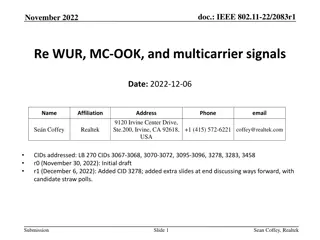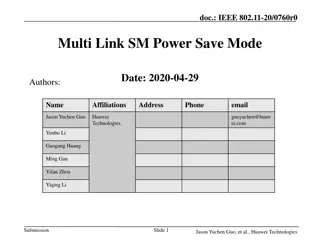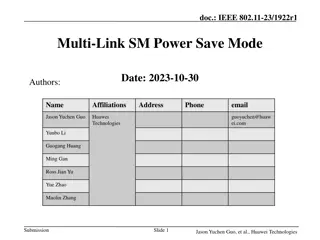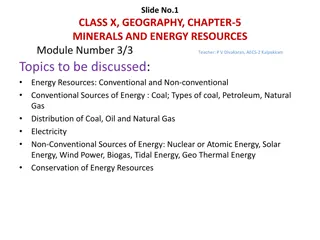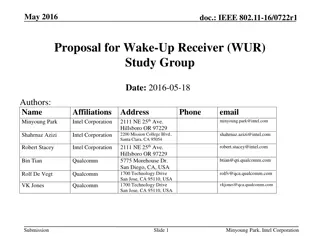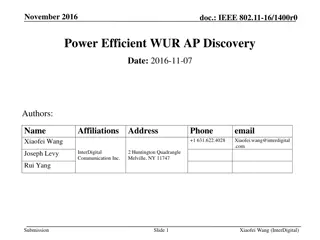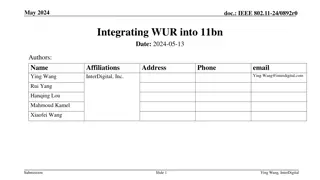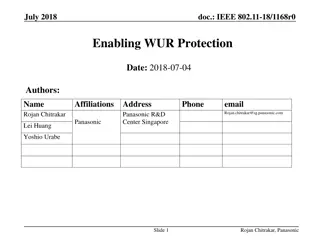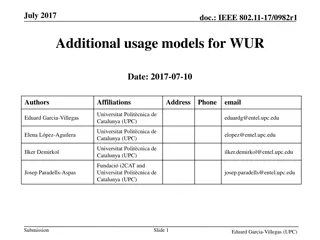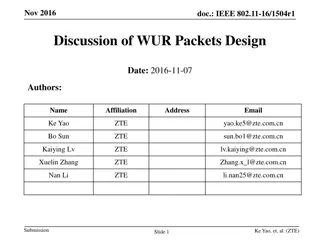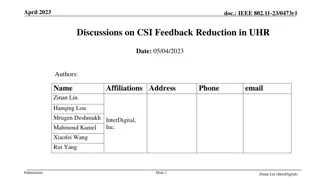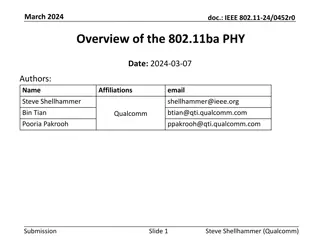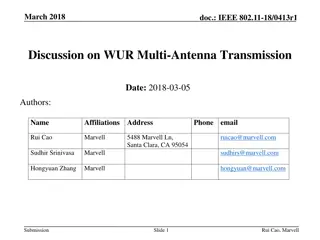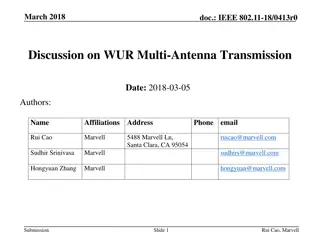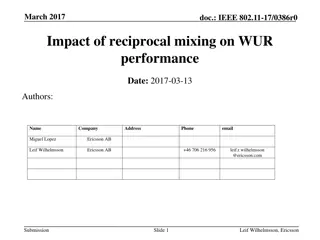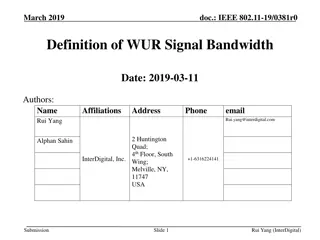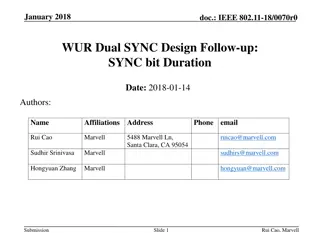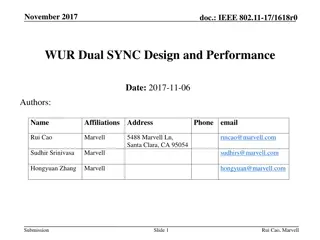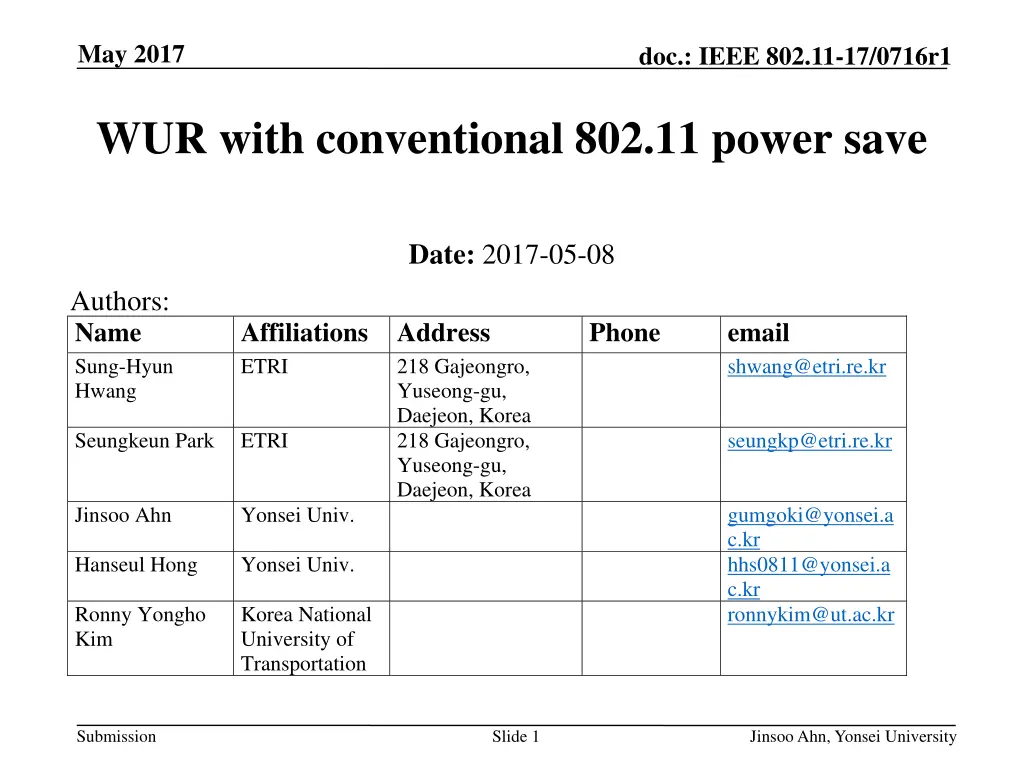
IEEE 802.11-17/0716r1 WUR Procedure for Power Save Mechanisms
Explore the WUR procedure within conventional 802.11 power save mechanisms based on the May 2017 IEEE document. The document delves into considerations for multicast and unicast WUR signals, the role of PSMP, U-APSD, and more in optimizing power savings for multiple users.
Uploaded on | 0 Views
Download Presentation

Please find below an Image/Link to download the presentation.
The content on the website is provided AS IS for your information and personal use only. It may not be sold, licensed, or shared on other websites without obtaining consent from the author. If you encounter any issues during the download, it is possible that the publisher has removed the file from their server.
You are allowed to download the files provided on this website for personal or commercial use, subject to the condition that they are used lawfully. All files are the property of their respective owners.
The content on the website is provided AS IS for your information and personal use only. It may not be sold, licensed, or shared on other websites without obtaining consent from the author.
E N D
Presentation Transcript
May 2017 doc.: IEEE 802.11-17/0716r1 WUR with conventional 802.11 power save Date: 2017-05-08 Authors: Name Sung-Hyun Hwang Affiliations Address ETRI Phone email shwang@etri.re.kr 218 Gajeongro, Yuseong-gu, Daejeon, Korea 218 Gajeongro, Yuseong-gu, Daejeon, Korea Seungkeun Park ETRI seungkp@etri.re.kr Jinsoo Ahn Yonsei Univ. gumgoki@yonsei.a c.kr hhs0811@yonsei.a c.kr ronnykim@ut.ac.kr Hanseul Hong Yonsei Univ. Ronny Yongho Kim Korea National University of Transportation Submission Slide 1 JinsooAhn, Yonsei University
May 2017 doc.: IEEE 802.11-17/0716r1 Introduction WUR AP could transmit both multicast WUR signal and unicast WUR signal[1] Multicast WUR signal could be transmitted for transmitting multicast or broadcast frame(s) WUR procedures for the conventional 802.11 power save mechanisms are not defined in 802.11ba Is it independent issues? Or is WUR procedure performed with the conventional power save mechanism? Multiuser WUR shall be considered because of its delay and power save requirements PSMP is the conventional power save mechanism for multi user case Submission Slide 2 JinsooAhn, Yonsei University
May 2017 doc.: IEEE 802.11-17/0716r1 Recap : 802.11 power save PS-poll frame can be transmitted after TIM reception U-APSD is a power save mechanism which is initiated by an uplink STA PSMP frame is multicast(broadcast) frame for initiating power saving service period for multiple users Submission Slide 3 JinsooAhn, Yonsei University
May 2017 doc.: IEEE 802.11-17/0716r1 PS-poll with WUR Beacon with TIM Wakeup Frame AP ACK PS- POLL STA Power State Sleep WAKE DELAY WAKE Without any changes on the conventional power save procedure, WUR could be utilized However it requires large delay and additional power usage due to TIM reception delay Submission Slide 4 JinsooAhn, Yonsei University
May 2017 doc.: IEEE 802.11-17/0716r1 U-APSD with WUR Wakeup Frame AP ACK DATA or NULL STA Power State Sleep WAKE DELAY WAKE Without any changes on the conventional U-APSD procedure, WUR could be utilized U-APSD does not require additional delays caused by channel access of an AP because presence check is initiated by an uplink STA Submission Slide 5 JinsooAhn, Yonsei University
May 2017 doc.: IEEE 802.11-17/0716r1 Unicast WUR power save From the motion result of the last meeting, unicast wake- up procedure has the following procedure[2] R.4.5.2.A: After AP sends a unicast wake-up packet to a STA, AP waits for a timeout interval If AP receives any transmission from the STA within the timeout interval, then the wake-up packet transmission is successful Otherwise, the wake-up packet transmission fails, and AP may retransmit the wake-up packet to the STA It means U-APSD could be utilized for WUR procedure but the conventional PS-poll method shall not be supported Submission Slide 6 JinsooAhn, Yonsei University
May 2017 doc.: IEEE 802.11-17/0716r1 Unicast WUR power save Wakeup Frame AP ACK PS-Poll STA Power State Sleep WAKE DELAY WAKE If PS-poll frame is needed to be utilized in WUR procedure, spec shall specify to regard WUR frame reception as a TIM reception The procedure is identical to U-APSD but only difference is that the uplink frame is a PS-poll frame Submission Slide 7 JinsooAhn, Yonsei University
May 2017 doc.: IEEE 802.11-17/0716r1 Multicast WUR power save From the motion result of last meeting, multicast wake-up procedure has the following procedure[2] R.4.5.3.B: After the transmission of broadcast wake-up frame, the AP can transmit broadcast/multicast frames through primary connectivity radio after the preparation period. It means the AP could transmit Trigger Frame or PSMP frame which initiates multi-user TXOP after the preparation period However, MU PPDU is not supported in this case Submission Slide 8 JinsooAhn, Yonsei University
May 2017 doc.: IEEE 802.11-17/0716r1 PSMP with WUR Wakeup Frame AP PSMP DATA DATA DATA DATA DATA +ACK STA Power State Sleep WAKE DELAY WAKE Shallow Sleep WAKE Because wake-up frame and the preparation period do a role of time scheduler, additional scheduling procedure for PSMP frame is not needed Multiple users could be supported and WUR STAs could be set to doze state during PSMP service period Submission Slide 9 JinsooAhn, Yonsei University
May 2017 doc.: IEEE 802.11-17/0716r1 Conclusions For unicast wake-up procedure, U-APSD could be utilized and it does not require any changes on existing spec In order to utilize PS-poll frame, some changes or some expedients shall be followed(e.g., regarding WUR frame reception as a TIM reception) For multicast wake-up procedure, using PSMP could be a solution It provides scheduling information over its PSMP service period If a STA is not scheduling in the PSMP service period, it could be set to doze state immediately Group addressed transmission time need to be used for MU transmission period Submission Slide 10 JinsooAhn, Yonsei University
May 2017 doc.: IEEE 802.11-17/0716r1 References [1] 11-17-0124-04 WUR MAC and Wakeup Frame [2] 11-17-0575-00 Specification Framework for TGba Submission Slide 11 JinsooAhn, Yonsei University
May 2017 doc.: IEEE 802.11-17/0716r1 Straw poll Do you agree to add the followings to 802.11ba SFD? 802.11ba should be able to be operated with the conventional 802.11 power save procedures. Y/N/A 13/3/15 Submission Slide 12 JinsooAhn, Yonsei University

